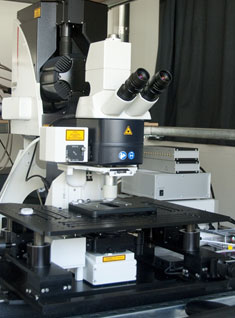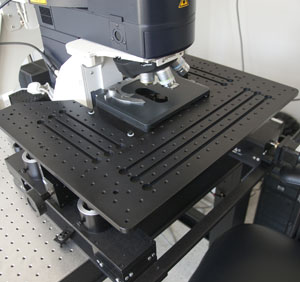Two photon system
The Center operates a Leica TCS SP5 FS Fixed stage, Upright microscope
This microscope was configured to enable high sensitivity vital imaging. This intent is  apparent in the detectors available, the DODT gradient contrast method, the scanning mechanisms, the stage, the objectives available, and the accessory equipment.
apparent in the detectors available, the DODT gradient contrast method, the scanning mechanisms, the stage, the objectives available, and the accessory equipment.
Detectors
The microscope is equipped with a pair of non-descan detectors (NDDs) for reflected light and a pair of substage NDDs. These substage detectors, used in combination with the reflected light detectors, provide, if your specimen is transparent, an increased ability to detect any emitted fluorescence. In addition the microscope has a substage detector that can be used for transmitted light and is equipped for DODT gradient contrast. Finally, the microscope has a PMT for reflected light that, like the confocal, is located behind a prism enabling the bandwidth and range of wavelengths detected by this PMT to be precisely controlled.
Scanning mechanisms
This microscope has two different scanning mechanisms: a galvo-based scanner like that on the confocal whose scan rate can achieve up to five 512 X 512 frames per second, and a resonant scanner capable of thirty 512 X 512 frames per second . The resonant scanning provides detection of dynamic fluorescence events, even those that occur in different parts of the field of view.
The Stage
The stage on this microscope is identical to that on the confocal. It provides for maximum flexibility in the types of specimens accommodated. There is a standard, manual x-y stage with slide holder, but this can be substituted with a solid platform that would accommodate a small animal or a investigator-designed and constructed platform that accommodates any variety of dishes/tissue holders. This stage can be manually lowered/raised so that a variety of thicknesses of specimens can be placed under the microscope objectives. Lastly, the stage has x-y motors so the x-y position can be controlled from the software.
Objectives
The microscope is commonly operated with a one position nosepiece. A special $25K dipping objective (20X 1.0 NA 2 mm working distance) is available for trained users, but the microscope can be operated with either of the two nosepieces available for the confocal and any of the lenses listed in the description of the confocal.
Accessory equipment
The accessory equipment available for the 2 photon is the same as that on the confocal: a heated CO(2) incubator around the stage, a thermistor-controlled in-line heater for perfusion fluids, and a heated stage.
IR Laser
For 2P excitation the microscope utilizes a Coherent Chameleon Laser tuneable between 690 and 1040 nm
Filter Sets
As described above, there are a pair of NDDs below the stage and and a pair below the stage. Each pair has a single filter cube in front of it. The incoming light first goes through an IR filter (SP680) and then encounters a dichroic mirror. There is then a filter on each the transmitted and reflected light paths from the dichroic on the way to each of the 2 NDDs. In the common set-up of the microscope, the configuration is: dichroic 560; transmitted filter 585/40; reflected 525/50. Leica calls this a FITC-TRITC cube
The Center has an additional 2 filter sets that Leica calls DAPI-FITC: dichroic 495; transmitted 460/50; reflected 525/50
We also have 3 empty cubes and a set of dichroics and BP filters for mounting in these cubes or substituting for filters in the existing cubes
- dichroic: one 505
- BP filters: two 605/70
- two 645/65
- one 480/40
- one 535/30
Other
The microscope is equipped for standard, widefield epi-fluorescence, including filter cubes for TRITC, FITC, and DAPI.
